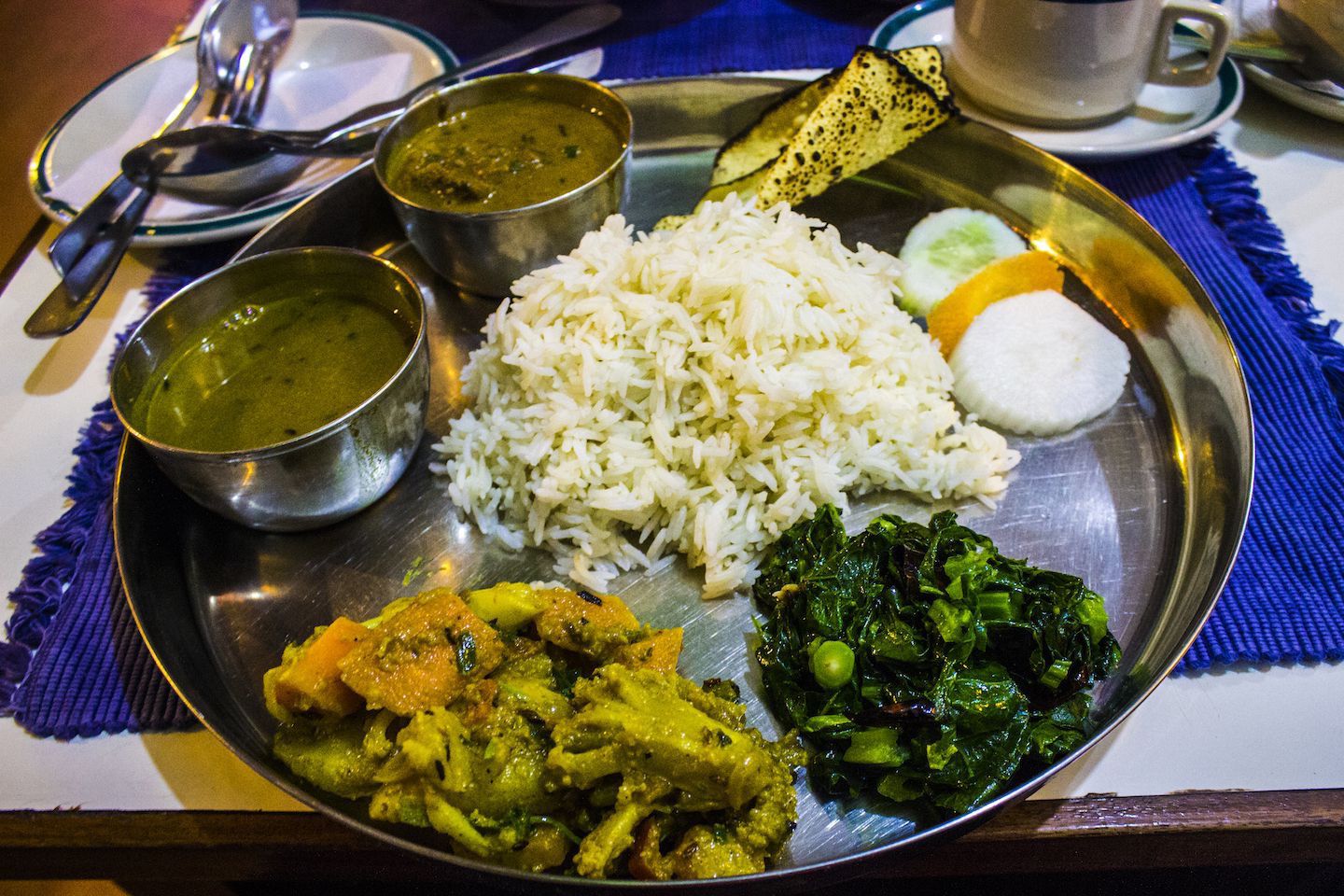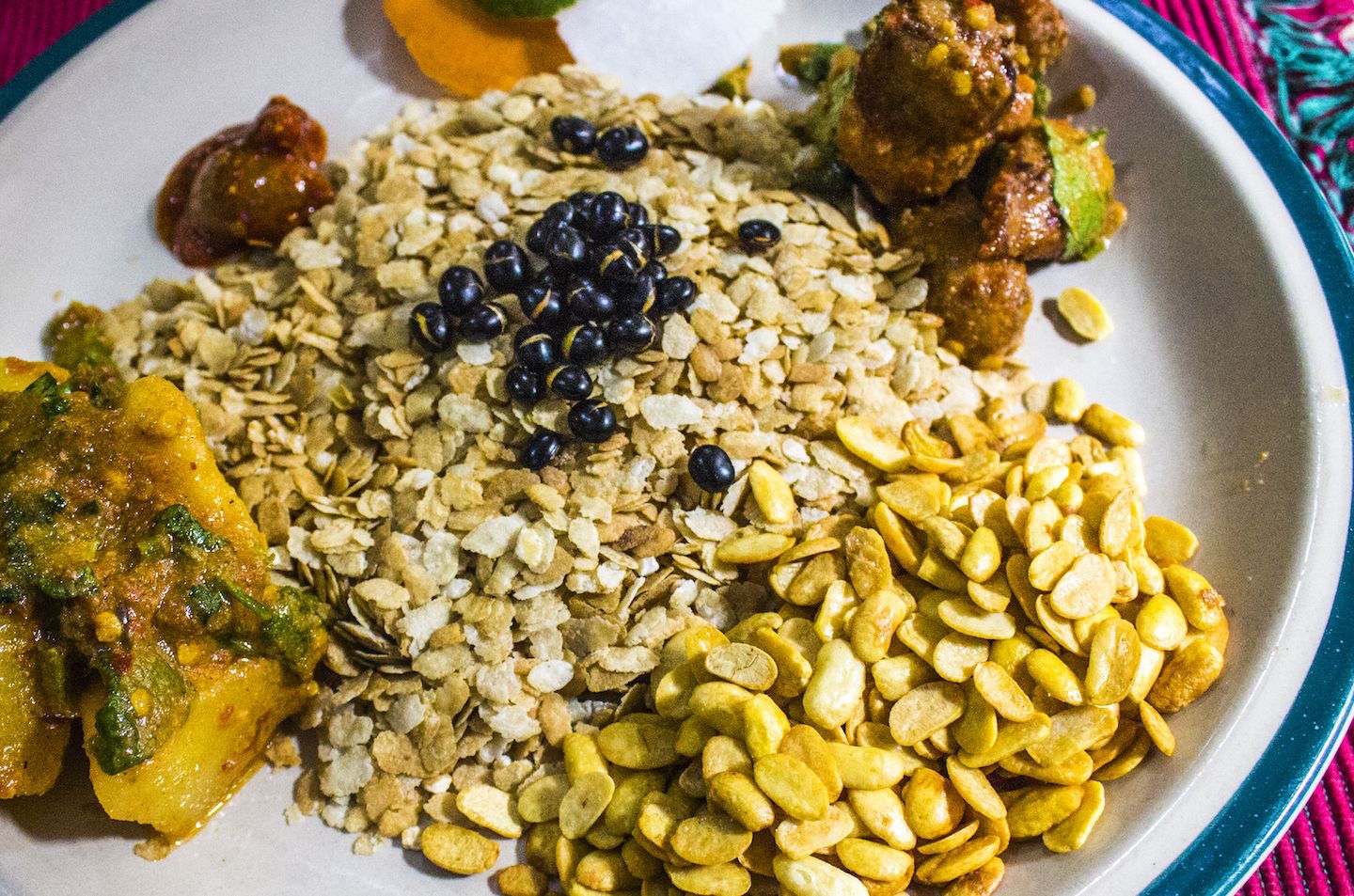After just a few weeks in Nepal, I went from being wholly uneducated about Nepalese food to becoming a fan. Despite being a meatlover, I really enjoyed the many vegetarian options in Nepal. There will definitely be visits to Nepalese restaurants in the future, that’s for sure. What will I order when I go? Well, there will be so many things to choose from.
Dal Bhat
As the saying goes, “Dal bhat power, 24 hours.” The entire country is fueled by dal bhat. Locals have it three meals a day, and sometimes we did, too. Especially on the trek in the mountains, dal bhat was the only thing truly filling as dal bhat always came with seconds. More rice, more dal, more potatoes or whatever the side dishes were. Whenever we felt really hungry and wanted an abundant meal, we ordered dal bhat!

The beauty of dal bhat was that even though everyone ate and cooked dal bhat, every single kitchen served it a little differently. Dal bhat also comes vegetarian or non-vegetarian (meaning with a meat curry of some sort). During the trek at teahouses, there were only vegetarian options. Given the meat lovers that we are, it’s a testament to how good the vegetarian dal bhat was that we found it to be both filling and yummy.

All the dal bhat we had came with steamed rice and dal (a lentil soup) of some sort. All the other parts of the meal varied seasonally and geographically – examples include vegetable (potato) or meat curry, yogurt, home-made pickle (a small portion of spicy and salty pickled vegetables) and papad (a crispy, thin piece of dough, reminiscent of a taco). For those preparing for trekking in Nepal, I recommend having dal bhat at least once in Kathmandu or Pokhara to try it out.
Momo
A Nepalese dumpling, Momo reminded me very much of Chinese dumplings (which I love). They were one of the first things I had in Nepal because they were familiar to me. One unique aspect were the buffalo ones filled with buffalo meat. They were the only meaty options besides chicken, and they were pretty tasty.

There was always a choice for how the momos were cooked. Steamed, which was standard. Fried, which explains itself. “Kothey,” which meant pan-fried, one side steamed, one side fried (we love this at my house!). Another variation occasionally available were “chilly” momos, which was basically momos cooked in chili sauce. I could always count on momos to taste a bit like home.

Khaja
We ordered a khaja set one day for fun, just to try it out. When the waiter asked us if we were sure, we stuck with the order but became a bit apprehensive. Luckily we enjoyed it! It turned out that a khaja set was a bunch of Nepalese snacks all on one plate.

The beaten rice was chewy, while the bhatmas (soy beans) had a great crunch to them. Paneer chili, aloo ko achar (a Nepalese spicy patato salad) and a side pickle dish completed the dish. It wasn’t the best entree as khaja was meant for snacks, but we were glad we gave it a try.
Thukpa and Thenthuk
I didn’t know this when I had it, but both thukpa and thenthuk were noodle soups that originated in Tibet. Due to many Tibetan immigrants in Kathmandu, thukpa and thenthuk were very popular. It’s always interesting to see how other cultures affect the local cuisine. Thenthuk is a variant of Thukpa that uses hand-drawn noodles.

I found the soup bases for thukpa and thenthuk to be a bit spicy and peppery, which made my whole mouth tingle (not necessarily in a bad way). This made sense as the Nepalese versions of thukpa and thenthuk contained chili powder and masalas. They were not my favourite noodle soups ever, but good for when I wanted something warm and easy to digest.
Bara
Bara was another dish we tried out of curiosity that we were glad we tried. Bara was a Nepali pancake made out of powdered lentils that was then fried. Eggs can jazz things up, or meat can also be added to make non-vegetarian bara. It was not as doughy as a western pancake, but more like a paddy of lentils and eggs or meat.

Our luck with food was pretty good in Nepal and we liked all the culinary risks we took. We loved the big portions, which gave us the sustenance we needed to keep warm. The positive initial experiences made us comfortable eating Nepalese food consistently for most of our stay in Nepal. During the latter parts, we began eating more familiar foods for variety, but still occasionally went back for some Nepalese classics. Dal bhat power, 24 hours!

